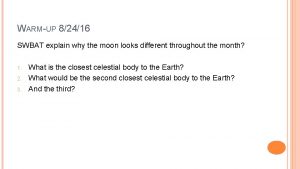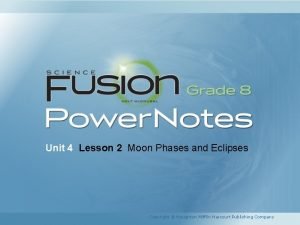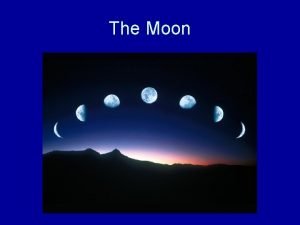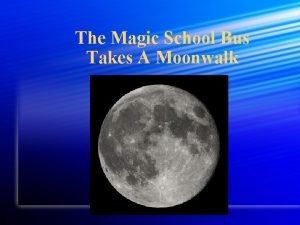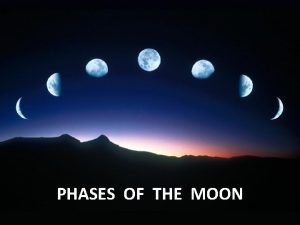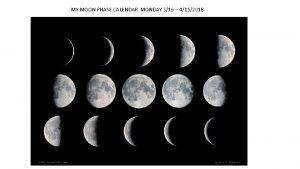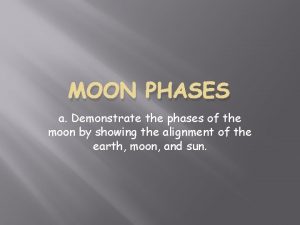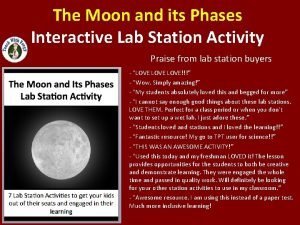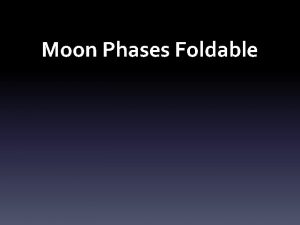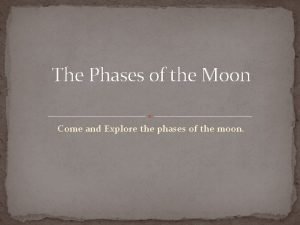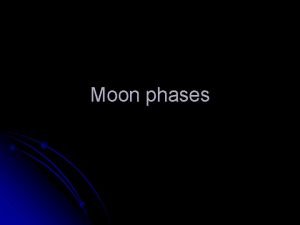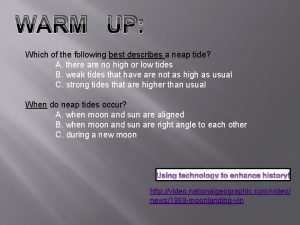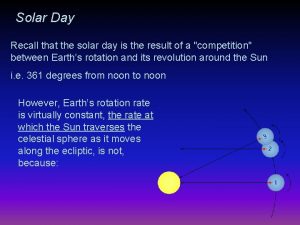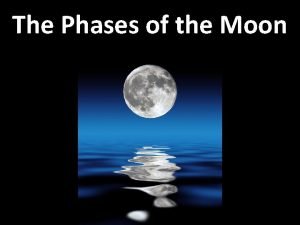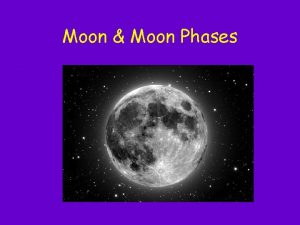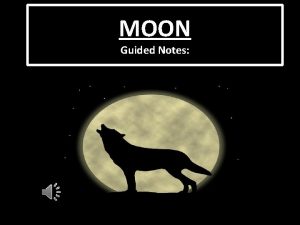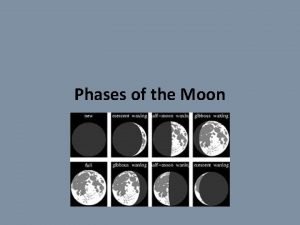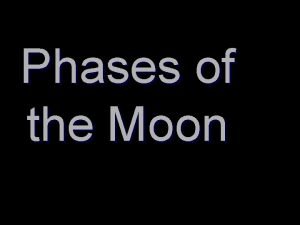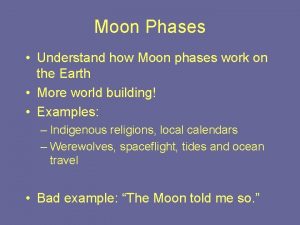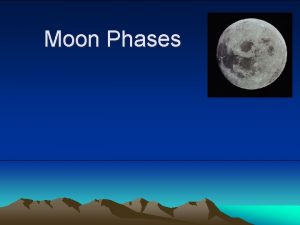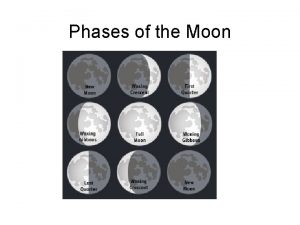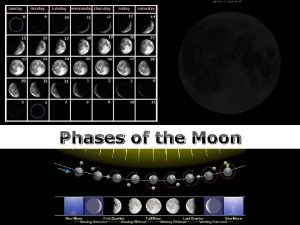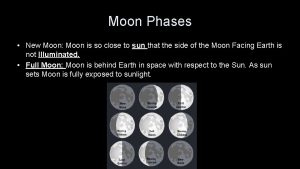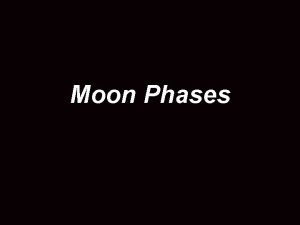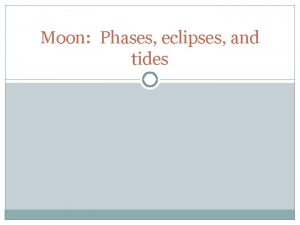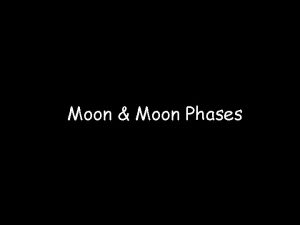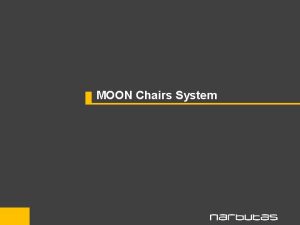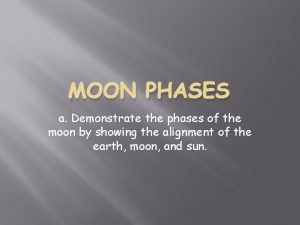The SunEarthMoon System Phases of the Moon The




















- Slides: 20

The Sun-Earth-Moon System Phases of the Moon • The sequential changes in the appearance of the Moon are called lunar phases. – A new moon occurs when the Moon is between Earth and the Sun and we cannot see the Moon because the sunlit side is facing away from us. – As the Moon moves along in its orbit, the amount of reflected sunlight that we can see increases until we are able to see the entire sunlit side of the Moon, known as a full moon. – Once a full moon is reached, the portion of the sunlit side that we see begins to decrease as the Moon moves back toward the new-moon position.

The Sun-Earth-Moon System Phases of the Moon

The Sun-Earth-Moon System Phases of the Moon Synchronous Rotation – Synchronous rotation is the state at which orbital and rotational periods are equal. – As the Moon orbits Earth, the same side faces Earth at all times because the Moon has a synchronous rotation, spinning exactly once each time it goes around Earth.

MOON PHASES

The Sun-Earth-Moon System Motions of the Moon • The length of time it takes for the Moon to go through a complete cycle of phases is called a lunar month. • The length of a lunar month is about 29. 5 days, which is longer than the 27. 3 days it takes for one revolution, or orbit, around Earth. • The Moon also rises and sets 50 minutes later each day because the Moon has moved 13° in its orbit over a 24 -hour period, and Earth has to turn an additional 13° for the Moon to rise.

The Sun-Earth-Moon System Motions of the Moon

The Sun-Earth-Moon System Solar Eclipses • A solar eclipse occurs when the Moon passes directly between the Sun and Earth and blocks our view of the Sun. – When the Moon perfectly blocks the Sun’s disk, we see only the dim, outer gaseous layers of the Sun in what is called a total solar eclipse. – A partial solar eclipse is seen when the Moon blocks only a portion of the Sun’s disk.

The Sun-Earth-Moon System Solar Eclipses • The shadow that is cast on Earth consists of two regions. • A total eclipse occurs in the inner portion called the umbra, which does not receive direct sunlight. • A partial eclipse occurs in the outer portion of the shadow called the penumbra, where some of the Sun’s light reaches.

The Sun-Earth-Moon System Solar Eclipses

The Sun-Earth-Moon System Solar Eclipses The Effects of Orbits – The Moon’s orbit is tilted 5° relative to the ecliptic and usually the Moon passes north or south of the Sun as seen from Earth, during a new moon. – A solar eclipse can occur only when the intersection of the Moon and the ecliptic is in a line with the Sun and Earth.

The Sun-Earth-Moon System Solar Eclipses The Effects of Orbits – The Moon’s distance from Earth increases and decreases as the Moon moves in its elliptical orbit around Earth. • Perigee is the closest point in the Moon’s orbit to Earth. • Apogee is the farthest point in the Moon’s orbit from Earth. – When the Moon is near apogee, it appears smaller, and thus it does not completely block the disk of the Sun, resulting in an annular eclipse.


The Sun-Earth-Moon System Lunar Eclipses • A lunar eclipse occurs when the full Moon passes through Earth’s shadow. • A lunar eclipse can happen only at the time of a full moon, when the Moon is in the opposite direction from the Sun. • A total lunar eclipse occurs when the entire Moon is within Earth’s umbra. • Solar and lunar eclipses occur in almost equal numbers, with slightly more lunar eclipses.

The Sun-Earth-Moon System Lunar Eclipses

TOTAL ECLIPSES OF THE SUN

TEACHER NOTES • INTRO TO UNIVERSAL LAW OF GRAVITATION • T-SHIRT DEMO • GO BACK TO OCEAN DISC INSTRUCTIONS

The Sun-Earth-Moon System Motions of the Moon Tides – The Moon’s gravity pulls on Earth along an imaginary line connecting Earth and the Moon, creating bulges of ocean water on both the near and far sides of Earth. – As Earth rotates, these bulges remain aligned with the Moon. – When the Sun and Moon are aligned along the same direction, the result is higher-than-normal tides, called spring tides. – When the Moon is at a right angle to the Sun-Earth line, the result is lower-than-normal tides, called neap tides.

THE MOON AND TIDES

The Sun-Earth-Moon System Section Assessment 1. Match the following terms with their definitions. ___ C ecliptic ___ A summer solstice ___ D winter solstice ___ B apogee A. occurs when the Sun is directly overhead at the Tropic of Cancer B. the point in the Moon’s elliptical orbit that is the farthest from Earth C. the plane that contains Earth’s orbit D. occurs when the Sun is directly overhead at the Tropic of Capricorn FL: SC. E. 1. 4. 1

The Sun-Earth-Moon System Section Assessment 2. Number the lunar phases in the correct order, beginning after the new moon. ___ 3 waxing gibbous ___ 4 full moon ___ 7 waning crescent ___ 6 third quarter ___ 2 first quarter ___ 5 waning gibbous ___ 1 waxing crescent
 Moon phases when the sun is on the left
Moon phases when the sun is on the left Lesson 2 moon phases and eclipses answer key
Lesson 2 moon phases and eclipses answer key What causes the phases of the moon
What causes the phases of the moon Magic school bus moon phases
Magic school bus moon phases Phases of the moon northern hemisphere
Phases of the moon northern hemisphere Hawaiian moon phases
Hawaiian moon phases What causes moon phases
What causes moon phases What causes the phases of the moon
What causes the phases of the moon Moon phases when the sun is on the left
Moon phases when the sun is on the left Which best explains why the moon has phases?
Which best explains why the moon has phases? Moon phases interactive notebook
Moon phases interactive notebook Moon phases foldable
Moon phases foldable Moon phases foldable
Moon phases foldable Whats the first phase of the moon
Whats the first phase of the moon Waxing vs waning
Waxing vs waning Phases of the moon jeopardy
Phases of the moon jeopardy Which statement best describes a neap tide?
Which statement best describes a neap tide? Moon phases
Moon phases Phases of the moon animation
Phases of the moon animation Moon phase bingo
Moon phase bingo During ____ phases more of the moon is visible each night
During ____ phases more of the moon is visible each night
